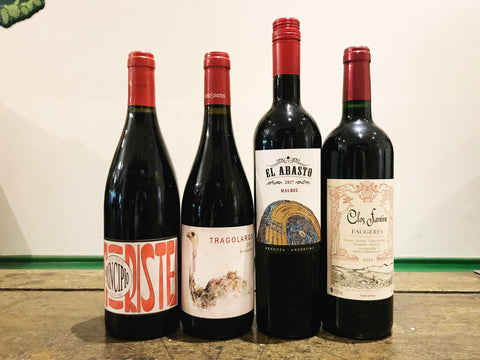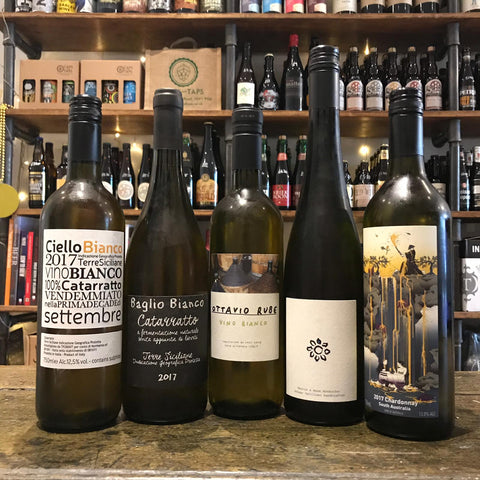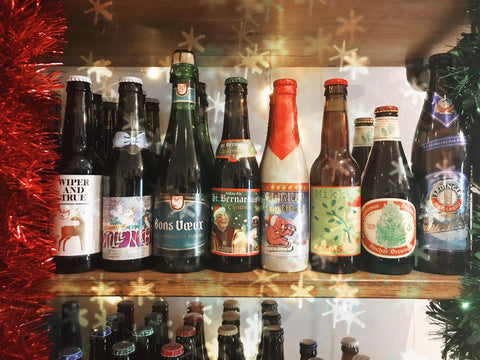In case you missed it, check out our last post looking at our new sparkling, white & orange natural wine selection. Today we’re looking at our eight new red wines, some from the same producers as our whites, and some totally new.

Starting with a familiar producer, Free Run Juice also make one of our reds - the Samurai Shiraz 2017. Again a recognisable grape variety, again one that can be pretty big, and again toned down a little by some freshness thanks to the cool region. This is not a typical jammy Aussie shiraz but instead it’s vibrant and juicy, with lots of plum and spice aromas. This would go great with a barbecue, grilled meats, and/or roast veggies.
We’ve also got a red from Ciello, the Ciello Rosso Nero d’Avola 2017. Nero d’Avola is another indigenous Sicilian grape variety, which typically makes a very hearty red. This producer, however, picks slightly earlier than average so the grapes have more freshness to them, making a lighter wine. This has similar flavours to the Shiraz, but with a bit of cherry in there too, and more tannins so would be great with sausages, mushrooms, and hearty pasta dishes like spag bol.
Moving to Spain, where half of our reds are from, we’ll start with 2 wines from Rioja. The first is from Gonzalo Grijalba, who makes his Gran Cerdo Tempranillo 2017 biodynamically. This means that as well as avoiding chemicals etc, he also decides when to plant, prune, harvest etc according to the lunar calendar. If you’ve heard about winemakers burying cow horns of manure, that’s biodynamics*. Pretty whacky maybe, but you can’t argue with results. Although this is made in Rioja, Gonzalo chooses not to put that on the label because he makes his wine so differently that he doesn’t want people to associate this wine with typical Rioja. Because this is young and unoaked, it’s full of red fruit aromas (strawberry, cherry, raspberry), with violets and minerality on the palate.
If you’re after a more typical Rioja, the Vina Ilusion Rioja 2016 should fit the bill. It’s basically autumn in a bottle - tons of spice (cloves and liquorice) and forest fruits (especially blackberry), but again a little bit fresher than many Riojas because it is a Rioja Joven (ie. young), and is unoaked. Thanks to its acidity and tannins, this is a brilliant food wine - it goes with just about anything!

Our other two Spanish wines are also the two lightest in the range. First up is Bodega Pirineos Principio Moristel 2016, from the Spanish Pyrenees, using the little-known Moristel grape variety. This wine was actually made just as a table wine for the co-operative’s winemakers until the Spanish buyer from Les Caves de Pyrene (our importer) tasted it and insisted they export it! It’s very similar to Gamay, that is light, juicy and fruity. It has fresh cherry and raspberry flavours, which come from the fact that, like Gamay, some of the berries go through carbonic maceration, which is where fermentation happens while the berries are still whole and attached to the stems. This is incredibly drinkable by itself, but also very versatile with food - it would go with a barbecue, white meat, goat’s cheese and veggie dishes.
In a similar vein is the Tragolargo Monastrell 2017, which is from Alicante in south-east Spain. Owner Bernabe Navarro never planned on becoming a winemaker, but bought the land to stop it falling into the hands of property developers, and then discovered it was perfect for grapes. This Monastrell is light and juicy like the Moristel, but it has a little bit of earthiness and spiciness to it rather than just fresh red fruit. Again, this is very drinkable all on its own, but a versatile food match as well. It would be particularly good with charcuterie, white and red meat (especially lamb), and tomato-based and spicy dishes.
Moving on to some bigger wines, we’ve got an Argentinian Malbec from the Uco Valley in Mendoza, El Abasto Malbec 2017. Just like the Vina Ilusion Rioja, this is definitely recognisably Malbec but with, you guessed it, a little bit more acid and less oak than normal. Although it is aged in oak, they use barrels that have been used before, so they don’t impart any flavour, you just get the effect of softened tannins, making it deliciously smooth. It has classic Malbec aromas of fig and red fruits, and it is full-bodied but without being jammy. It will still pair wonderfully with steak, as well other big meaty dishes like roast pork.
Saving (possibly!) the best till last, we’ve got the Clos Fantine Faugeres Tradition 2016. This is a totally natural red from Languedoc-Roussillon in the south of France. It’s a blend of the traditional southern French varieties Carignan, Grenache, Cinsault, Mourvedre and Syrah, making a big, hearty red, but with no added sulphur giving it some savouriness. On the nose it has a little bit of funkiness but this blows off really quickly to give meaty, smoky aromas, which turn into blackcurrant and herbs on the palate. It is the perfect wine for roast beef or venison, and it can handle spice too.
*If you want to read more about biodynamics, Wine Folly has a great introduction.


